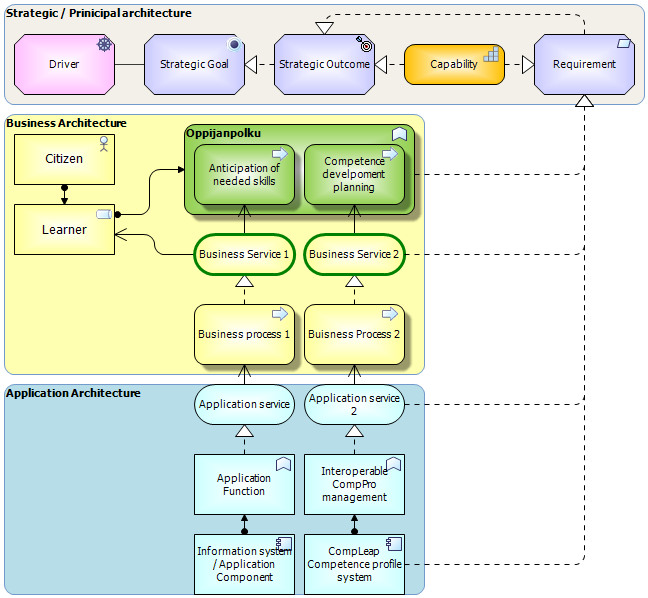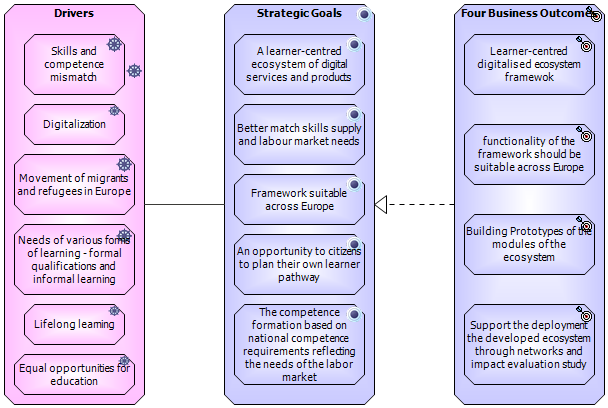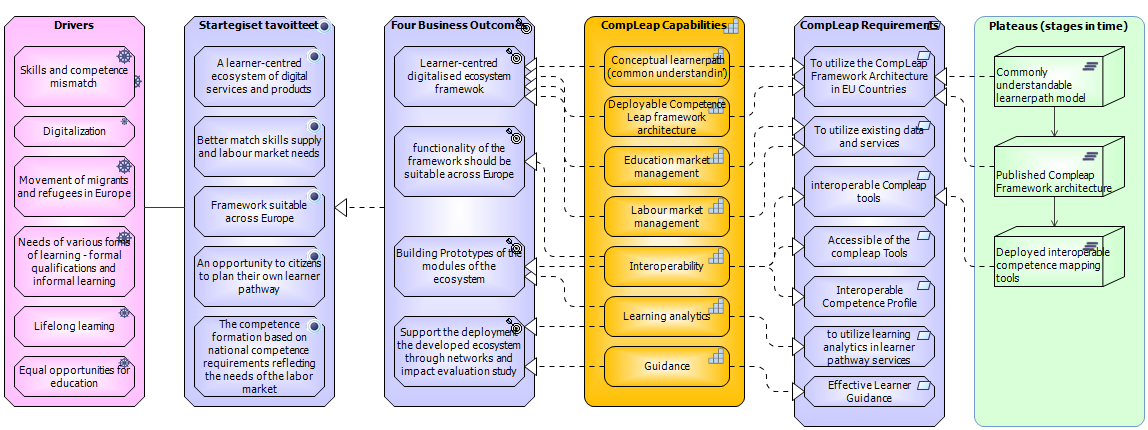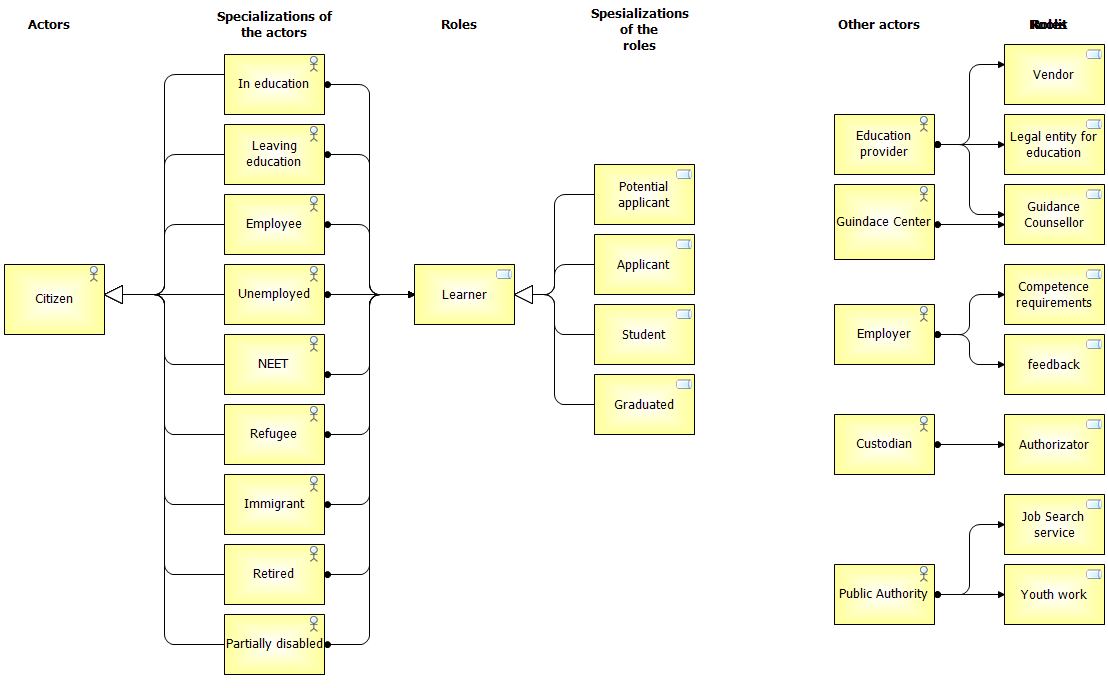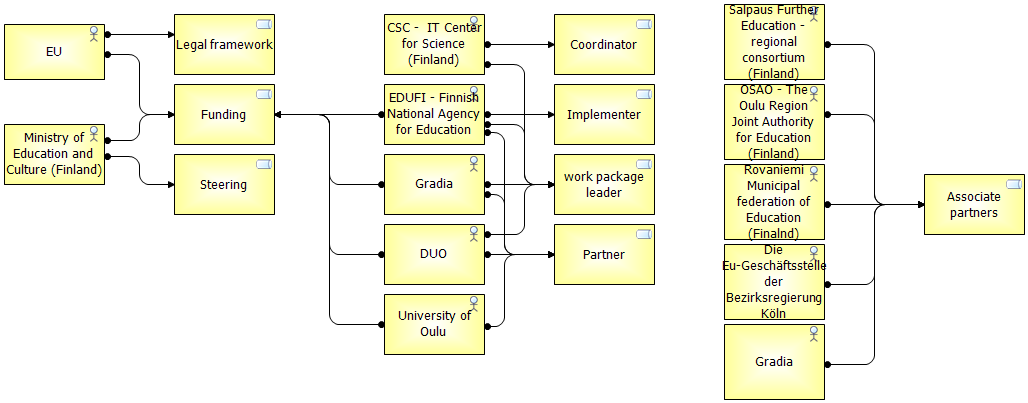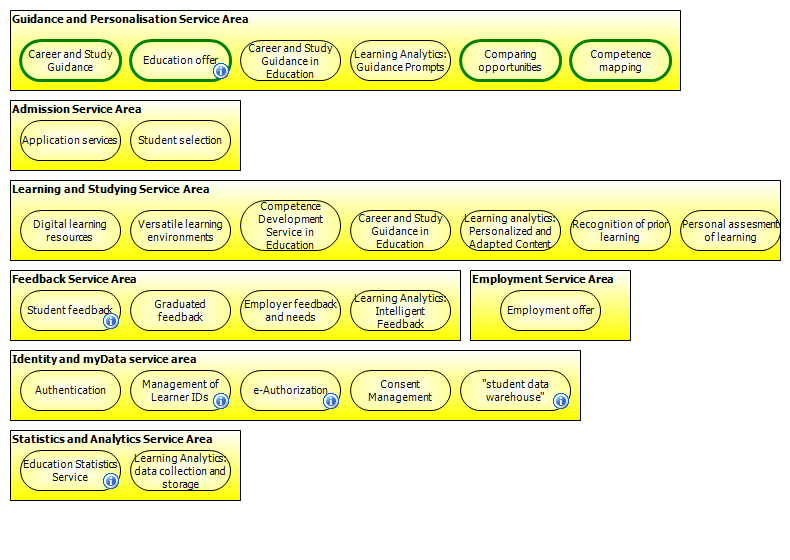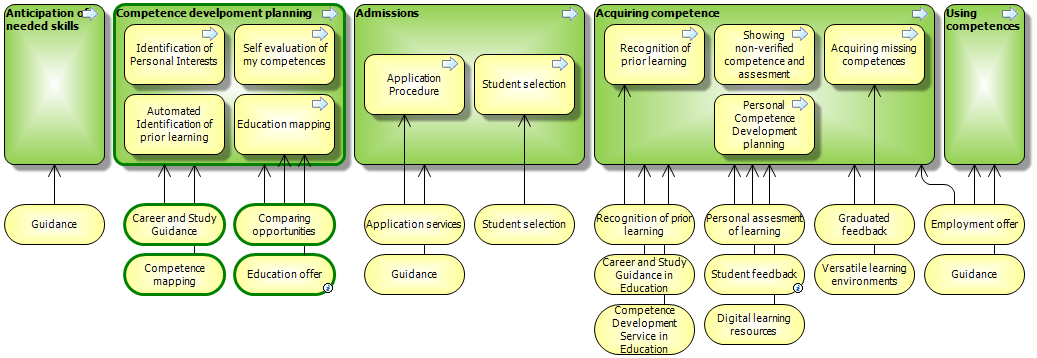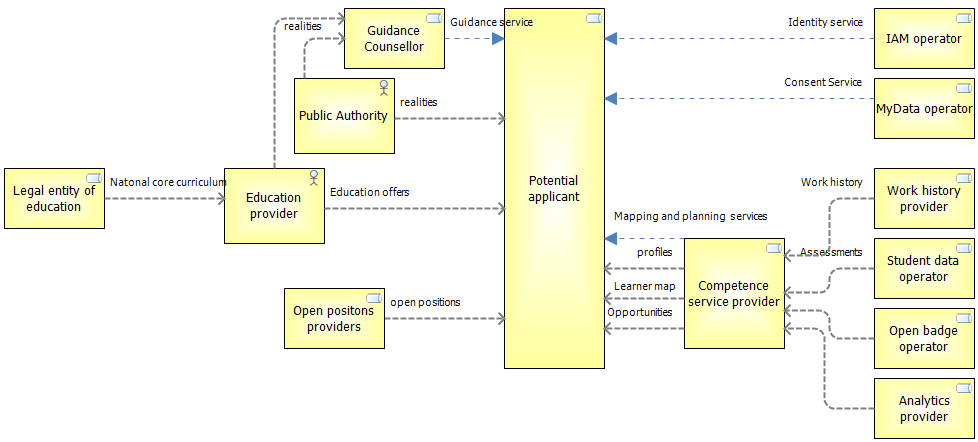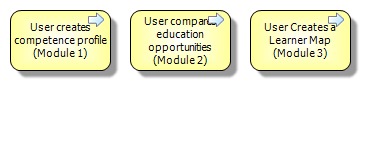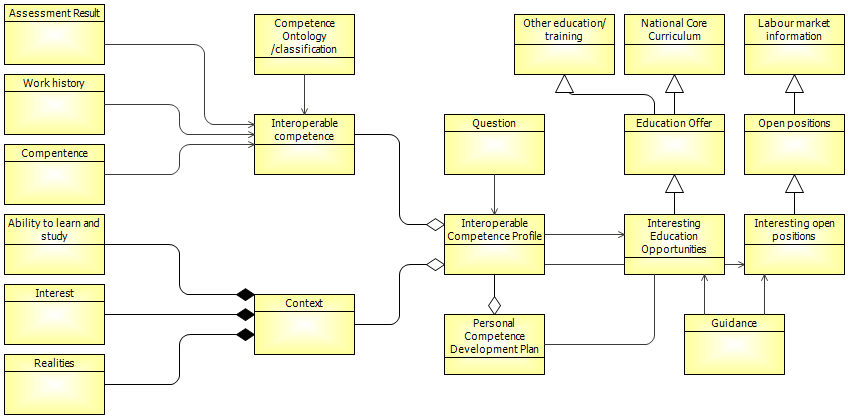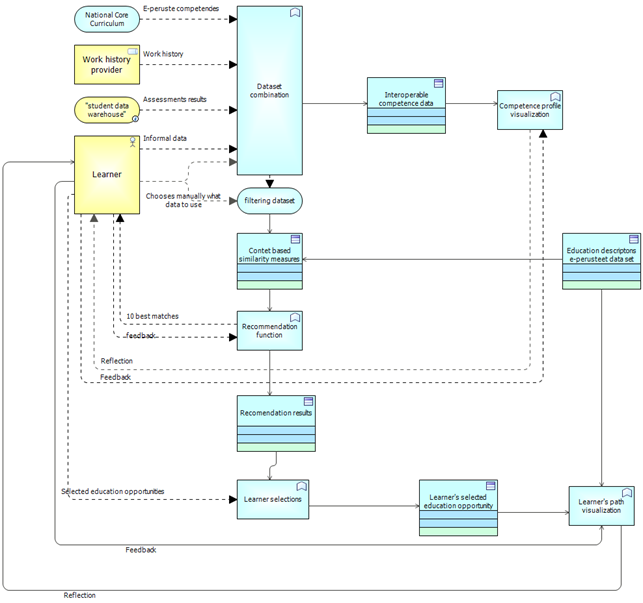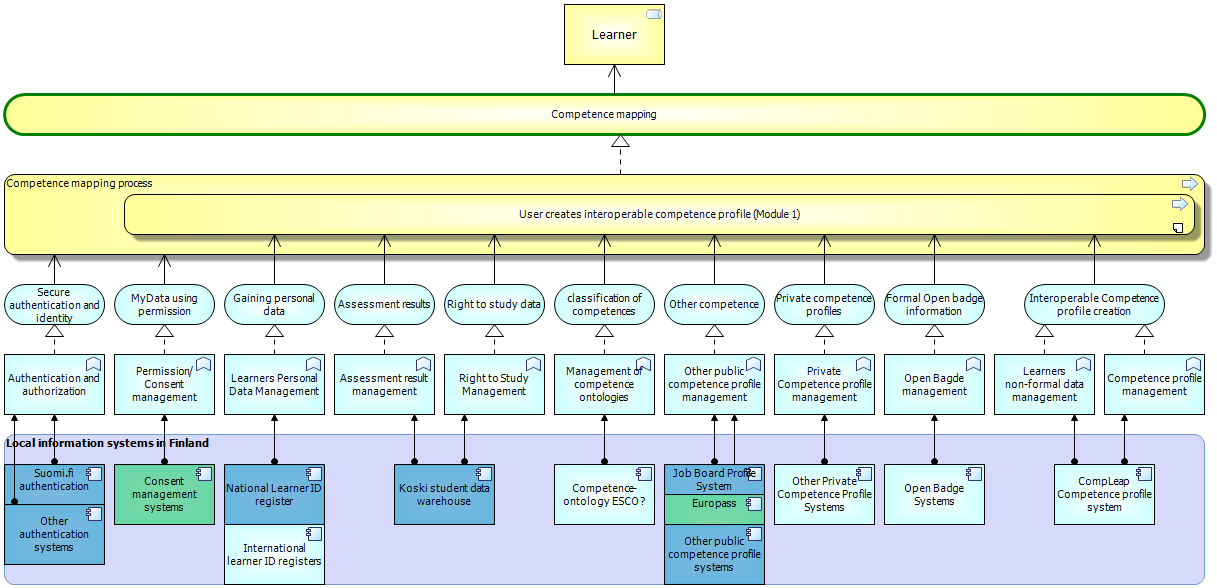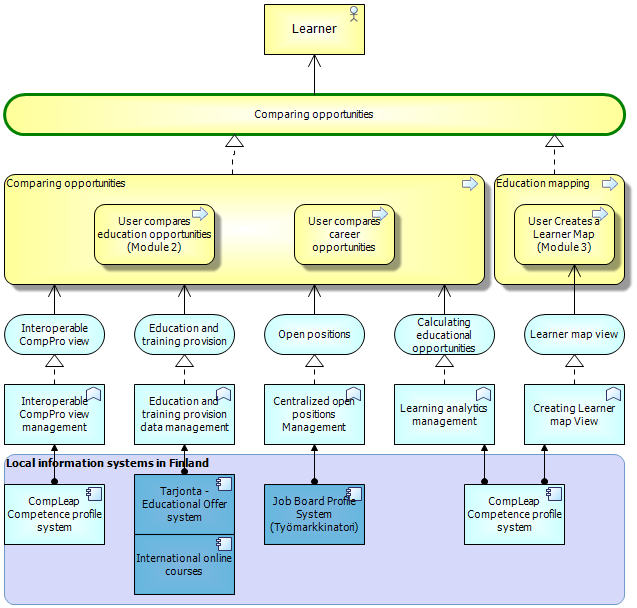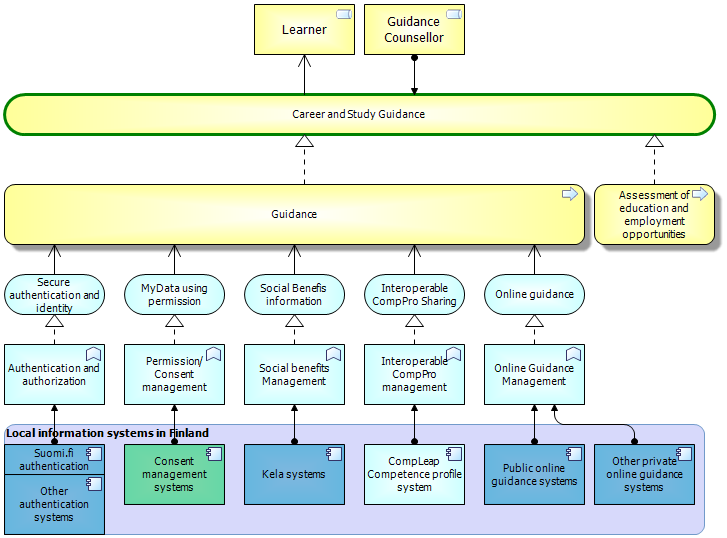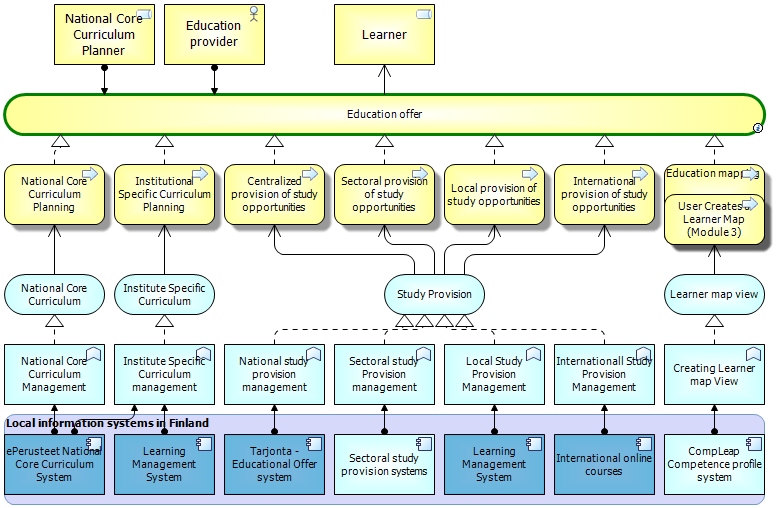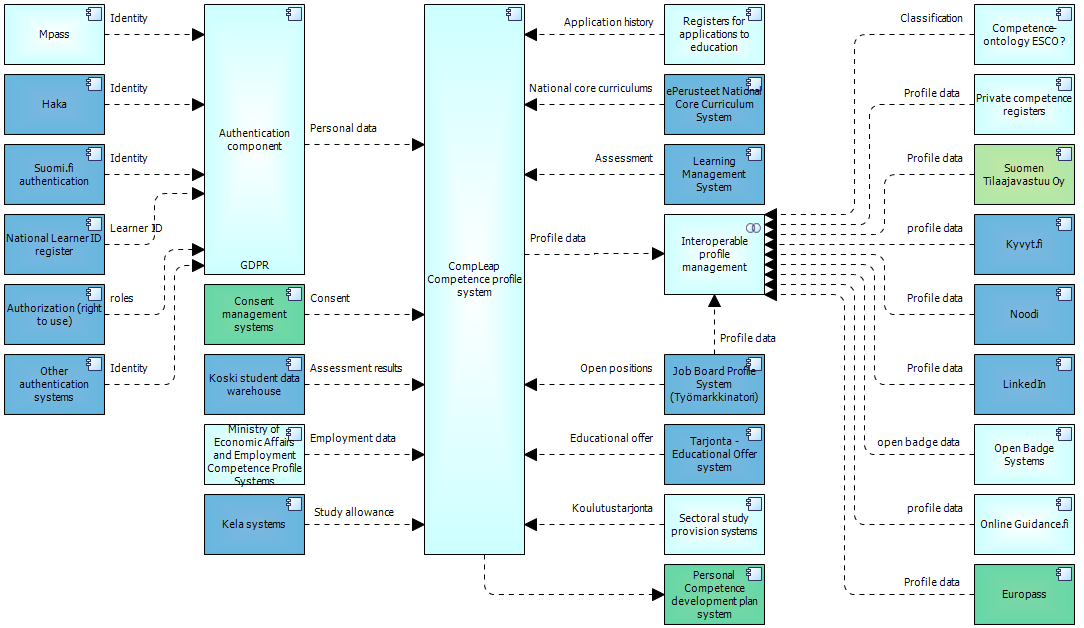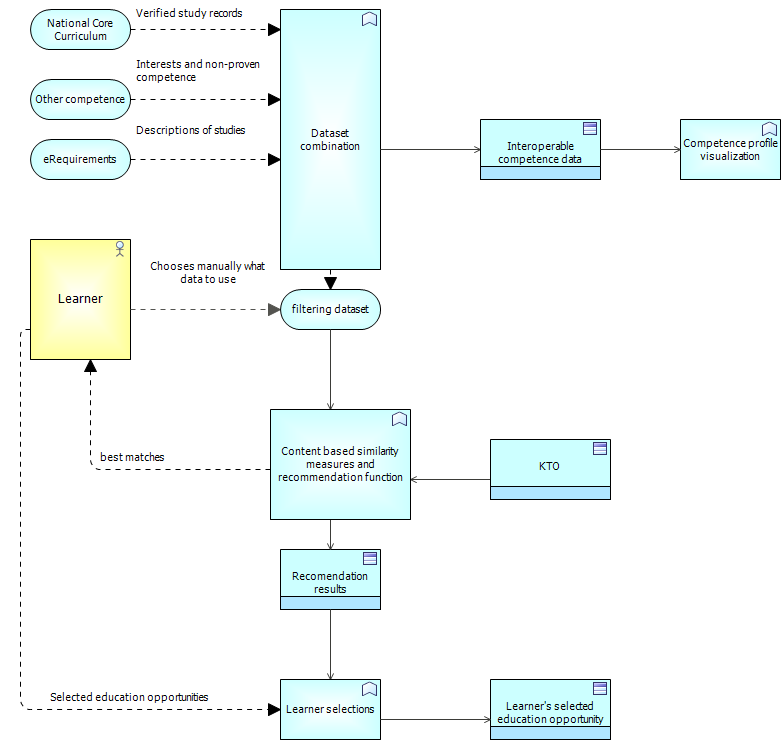Purpose
The framework architecture's purpose is to describe and visualize learner's pathway and available digital services at very generic level so that the framework can be deployed across the EU-member state countries. Such ecosystem framework could be used as a help when developing digital services for citizens.
The learner's pathway can be seen as a value stream which increments learner's competences and, thus, value in some sense. While the value stream is from learner's perspective, the services the learner uses on the path are produced by other actors. The services the learner uses are pinned on the path to tell when the learner is able to use that particular service. By expanding achitecture of the services the framework guides what is needed to implement the services and it is up to a user of the framework architecture to define how the services are actually implemented. To guide in implementation the framework architecture includes an example how this framework is implemented in Finland.
To whom this document is meant for
The document is meant for decision makers, strategy leaders and developers (education and employment services).
Conventions in the document - Compleap Framework Architecture Meta Model
CompLeap vision
The project aims to build a learner-centred ecosystem of digital services and products around skills and competences to better match skills supply and labour market needs, serving individual citizens, employers, decision-makers and, ultimately, the society at large. More specifically, the project aims to empower the citizen to take ownership of their skills development by offering them an opportunity to plan their own learner pathway based on enhanced self-awareness, improved recognition practices and responsive education offer. Furthermore, the skills formation will be based on national competence requirements reflecting the needs of the labor market.
1. Architecture Principles
Architecture Principles
Architecture principles guide organization development towards strategic goals. Every development decision should be aligned with principles. The power of principles is that everyone can utilized them in their everyday work and work towards strategic goals.
Strategy Map
Strategy map links drivers, strategic goals, business outcomes and capabilities together. Drivers motivate for business shift and strategic goals are long term development targets meeting the environment change. Business outcomes are concrete results realizing the strategic goals in short term development.
Strategy Map with Needed Capabilities and Development Requirements
Needed capabilities tell what capabilities organization needs to realize business outcomes. Capability appears when its different dimensions are developed. The different dimensions are people, processes and material. Development of people dimension includes development of personal competences, development of processes include processes, concepts and information management and development of material dimension includes infrastructure, information technology and equipment. CompLeap project development requirements describe what is needed to increase the recognized capabilities.
2. Business Architecture
CompLeap Actors and their Roles
The learner's pathway actors and roles are described above. Learner is the center role in the framework architecture and the the learner acts in different specialized roles in the leaner's pathway. The learner can potential applicant, applicant, student or graduated depending on at what stage the learner is in the learner's pathway. Learner can be potentially any citizen of European Union and the citizens are divided into different categories to focus services for them depending on their life situation. From the value stream point of view main actors producing more value to the learner are public authorities, education providers and employers. Education provider offers services to increase learners competencies and employer provides possibility to utilize the competences and turn competences to actual value.
Education provider acts in different roles, namely in vendor, legal entity of education and guidance, depending on what education provider's service the learner is using.
Employer acts in different roles to provide competence requirements and feedback.
CompLeap Project Actors
Compleap project actors are described above. From the framework point of view the roles are meaningful and the implementer of the framework should consider what roles are required to implement the framework and what are the actors or stakeholders (link to eduuni wp 5) in each role.
Business Service Map
Framework's business services are described above. In this framework business service produces value to the learner. The learner starts using the business service by contacting the actor producing the service. The contacting may occur via different channels which are up to an implementer to define. Some of the services require that the learner has to give some information as input to the service and the learner gets information back. Some of the services produce information for the other services to be utilized in the learner's pathway and some services give actual value increment to the learner. The while the business services may be fully automated there is still need for person-to-person interaction and, thus, service design should take other actors in account when applications are defined.
Compleap project focuses on the business services with green ovals around, namely Career and study guidance, Education offer, Comparing opportunities and Competence mapping. The project aims to create application prototypes for the named business services and the applications gives an possibility to use services via World Wide Web. The framework architecture and its implementation helps prototype implementation to give holistic view of all services and possible data streams so that data can utilized everywhere in the learner's path and the learner does not need to input same data many times on the path.
Guidance and Personalisation service area includes business services to help individuals to identify their competences and what competences they are missing and what course of actions they should take to improve their competence.
Admission service area includes business services to admit into education or other competence development.
Learning and studying service area includes business services to improve competence.
Feedback service area includes business services to give feedback about the competence development at any stage.
Employment service area includes business services to collect information about employment offer. This area could contain business service for applying to work but it is left out intentionally because of the perspective and scope of the framework.
Identity and myData service area contains business services to identify learner, to manage learner's personal data and consents.
Statistics and analytics service are contains business services to manage statistical and analytical data to provide information to different management levels.
Digital Learner Pathway - Target Phase
Learner's pathway is described above. The learner's pathway is main business process or value stream in the framework. The value stream defines the steps the learner takes to increment hers or his competence. The value stream begins from anticipation of needed skills where the learner somehow recognizes the need for new skills or competences. The learner may use guidance at every stage of the leaner's pathway and the guidance could give impulses to the learner at every stage to guide the learner to right direction. After the anticipation of needed skills the learner may do planning or do pre education personal competence development planning. The difference between the planning and pre education competence development planning is that the planning is not well structured process while the pre education personal competence development planning process is. The planning is more ad hoc and flexible and depends on the learner how to planning is done or if it is done at all. The pre education personal competence development planning is defined by legal entity of the education and is formal way to do planning at that stage. After planning the learner does education mapping and after finding proper education, the learner enters to admissions. After admissions the learner acquires competences and finally uses the competences. During acquiring the competences and using the competences the learner does personal competence development planning all the time. The personal competence development planning is also formal process defined by legal entity of the education which guides the learner to do planning all the time. While the learner may do other kind of planning also, the formal planning provides common tools and information to do planning in competence development scope.
Digital Learner Pathway - Main and Sub Processes
Learner pathway's sub business processes are described above. The sub processes clarify the main processes and tell in more detail what steps the learner takes in the learner's path.
Planning process is divided into three steps. Namely, identification of personal interests, self evaluation of my competences and automated identification of prior learning.
The sub processes are described in more detail later.
Admissions are divided into application procedure and student selection sub processes.
Acquiring competence is divided into recognition of prior learning, showing non-verified competence and assessment, and acquiring missing competences sub processes.
Digital learner pathway: Main Business processes and service
Learner's pathway supporting business services are described above. The business services are pinned to the learner's pathway using the arrow notation. The notation describes at which stage of the learner's pathway the business service is utilized. For example learner uses competence mapping business service during planning process.
Main and Sub Business Processes and Services
Impact and Socioeconomic effect
Learner's life situation is modeled in the framework architecture with a concept of realities. The concept includes anything concerning the learner's capabilities to work or study or to achieve learner's goals in general. Measuring the learner's capabilities is not an easy task but some can be approached with available data. For example if the potential applicant applies to studies and is accepted, the learner might get some student benefits like study allowance or cheaper accomodations or cheaper public transport tickets. On the other hand when the learner starts to study full-time, the learner might need to leave current work or start doing part-time work.This kind of realities can be modeled as currency flows in the learner's life. The changes in the currency flows are one sort of impact in the learner's life situation.
In general, impact can be thought as the changes in the realities in time. The impact in the learner's life is different depending on at what stage the learner is in the learner's pathway. While the learner can utilize the knowledge of impact when doing short term planning, the actual goal is to reach impact after the studies. In other words, long term impact.
In the framework architecture the long term impact can be defined as a change in learner's realities when learner begins the learner's pathway and ends the learner's pathway. The impact is not immediate when the learner begins utilizing the new acquired competences, so there should be some reasonable time to assess the impact after the studies.
Predicting the learner's short term impact might be possible if there is enough realities data available on different life situations. Predicting the learner's long term impact requires vaste amount of information like prediction about the job market situation after the studies, prediction of employment possibilities and so on. The system could also learn by time what kind of impact the learners have after traveling through learner's pathway. Comparing similar learner's meaning similar competence profiles, intents and goals, the impact estimation could be based on those. The impact estimation could be used in simulation how the choices in the learner's pathway would affect in short term and in long term. The simulation could help learner to make decisions for her or his good. If the prediction is not reliable and brings some ethical issues whether this kind of guidance is acceptable
The socioeconomic effect in this scope can be thought as a sum of all learner's long term impact in a certain time period. This kind of collective impact can be used to help decision making while planning the national core curriculum or budgeting and funding. The prediction of socioeconomic effect could be possible in similar way as in individual's impact prediction and also simulation would be possible in the same way.
Process Integration
Framework process integration is described above. The diagram shows how data concepts flow between processes.
Potential Applicant Interaction
Planning in Learner’s Pathway
Planning is part of learner’s pathway presented above. In the learner’s pathway there is three types of planning: planning (non-formal), pre education competence development planning and personal competence development planning. The document describes planning in learner’s pathway in more detail. What are process stages and data concepts inputted and outputted at every stage.
Learner's education gap is first identified on higher level and creates first plan which answers to the question “What education learner requires?” Pre education personal competence development planning process identifies learner's current education and target education and the difference between current and target education is the gap which is filled by Acquiring competence process. The same education gap can identified by Planning and Education mapping process but the process is more less defined by the learner herself or himself. After Admission the learner makes more detailed plan of her or his studies and the plan answers to the question “How the required education is acquired?”
First stage pre education personal competence development planning is identification of learner's current competencies. Current competencies are identified in competence mapping process. Competences can come from different sources and before the admission it is up to the learner what competences are relevant and how to emphasize the competences to achieve learner's interests and goals. Before admission the reliability of the competences are up to the learner her- or himself. The reliability is validated later in the learner's pathway process.
Current education is identified by comparing identified competences in national core curriculum. Some of the education is not formally recognized at this stage but can be recognized during Acquiring the competence process. Some of the current competences may not be found from national core curriculum but should be stored for later identification.
Target education is identified by the learner based on the learner's opportunities and interests.There is several ways to identify target education. The learner may choose education from national core curriculum, or education offer, or identify needed education through chosen competences or through chosen goals.
Learner chooses education from education offer straight. The selected education becomes target education. This requires the education offer data is available to the learner.
The learner may choose education from national core curriculum, also. The national core curriculum describes what education contains and competences can be learnt from the education. Before admission the learner has to map selected education to education offer to find education provider.
Learner can also identify single competences which she or he would like to learn and then find education providing those competences. This requires the competencies learner identifies are mapped to education. Learner can be interested in competencies not linked into education or not even provided by education, and in that case there should be a process to guide learner further.
Learner can identify the goal, for example career, and if there is data available between the goal and competencies, then goal's competences can be compared to education and find the target education through this kind of mapping. This requires data about goals and link between goals and competences.
Education gap is determined by comparing current and target education. In summary, first checking what education the learner already has comparing to current competencies and then checking what education learner should have by comparing to the target competencies. The education gap is the difference between the current and target educations. The key data is the link between competencies and education which in this case is defined to be in national core curriculum.
Instead of comparing the current and target competencies into national core curriculum which to get current and target education, it is also possible to get difference on current and target competences first and then find the education matching the difference.
After the learner has identified education gap, the learner can compare the education gap to the education offer and find the suitable education provider to acquire the education.
To map education offer to education gap, there should be either link between education offer and national core curriculum or link between education offer and competencies.
Education offer mapping can be done using just competence gap if there is a link between education offer and competencies. If education offer is linked to national core curriculum, the link from education offer to competencies can be determined through the national core curriculum.
Admission is controlled process which validates the learner's data. Each organization has its own admission process but some admission processes are controlled by national education authority. The input for the process is learner's recognized education and competencies and some other data for selection and output is rights to study, if the learner qualifies the selection criteria.
After admission PrePCDP (what education is needed to fill the education gap) can planned further in more detail together with education provider for exact information how, when and where the learner participates in education.
Planning and Education Mapping has same outcome as Pre education personal competence development process. Learner may have same choices as in pre education personal competence development process but available tools and services can come from anywhere.
Guidance can support planning at every stage. Before admissions the guidance providers can use their own tools to provide guidance services or they can help learner with Compleap tool. Either way the end result should be same from the learner's point of view, the learner gets enough guidance to admit to education according to hers or his interests and possibilities.
Learner uses Compleap tool On pre education personal competence development planning process on different stages: competence mapping, comparing opportunities and education mapping. If the learner goes through non-formal planning process the same services can be provided by other tools available in the market. The end result should be still the same, the learner knows what education the learner should acquire and the learner enters into admission process to fill in the education gap.
CompLeap Tool Processes
CompLeap tool processes are described above. The processes are part of learner's pathway and in defined in more detail to help implementation of prototypes. The process' details are described in following chapters.
Leaner creates Competence profile (module 1)
The Learner - generic user - starts to use CompLeap tools and creates My competence profile.
Learner Compare Education Opportunities (module 2)
Learner creates own Learner map (module 3)
3. Information Architecture
Conceptual Data Model
The framework's conceptual data model is described above. Main concept is interoperable competence profile (ICP). The interoperable competence profile contains set of interoperable competences and contexts and it is refined by questions. Interoperable competence is built from assessment results, work history, competences and badges. The context is build from interests and realities.
The information in ICP links to interesting education opportunities and open positions which are refined by guidance. Interesting education opportunities is realization of education offer which is realization of national core curriculum. Interesting open positions is realization of open positions.
The conceptual data model does not tell how the information is actually structured or modeled. From the framework perspective the concepts are recognized as something which is needed to make data flow smoothly among processes.
Analytics Data flow
Data flow model in the Compleap project illustrates how data flows in the Compleap user services. Information about formal education, previous work history is gathered automatically from other systems and databases. Information about non formal and informal education as well as interests comes from the manual user (learner) input. Specific data set is extracted and used as a data combination to visualize competences for the user and at the same time stimulate his reflection on his current competence situation. User can also manually select data combination and filters to get a education recommendation. This is content based recommendation. 10 best results are presented to the user where he can further select his favorites and proceed to learners path visualization where information about education option is visualized for the user again to promote his understanding of the studying and also self-reflection. User is also able to give feedback about competence and learners path visualizations as well as education recommendations.
Information flow described above leads to four main services provided: Competence visualization, education recommendation, education comparison and study guidance.
Competence visualization - there are certain competences acquired during the study process. These competences are usually described in the national curriculum and are at the core of the modern world of work and study. Although they are learnt and specified in documentation many students don't have enough information about them or maybe haven't even heard about them at all. Compleap service provides an opportunity to see clearly what competences have been studied during the study process in educational institution. Also what groups they make and what are the main or key competences as described by EU.
Education recommendation - education recommendations are calculated and based on similarity of content between user's profile data and education descriptions.
Education comparison - closest matches of between user's profile and education descriptions are presented to the user in ranking. Starting from the closest one to the less closer and so on. User can mark some recommendations as favorite and this way generate more suitable suggestion.
Study guidance - the whole service is seen as a study guidance and support for decision making. Information about own competences, previous experiences and interests are gathered in one place and presented in a user centered way to promote his reflection about studying possibilities. Education recommendation is provided not as a solution but as an encouragement for the person to think and reflect on his interest and future goals.
User is able to give feedback on the usefulness and accuracy of the the profile and education recommendations to further develop these services.
4. Information Systems Architecture (Application Architecture)
Layered Architecture views
Purpose of the models: Show processes, application services and information systems needed for providing CompLeap services.
Competence Mapping layered architecture view
Competence mapping layered architecture view is described above. The diagram describes the competence mapping service is implemented by competence mapping process. When learner uses the service the competence mapping process is executed. The learner gives information about her or himself and process outputs hers or his competences back to the learner.
In CompLeap context the whole competence mapping process is about to be digitalized by module 1 and the process of using digitalized tool is put inside the competence mapping process. In this case, User creates interoperable competence profile process implements the whole competence mapping process but in other implementations there can be manual stages also.
The blue ovals describe the application services supporting the competence mapping process. The application functions are implementations of application services and there could be many application functions which are categorized as same application service. In the diagram only the relevant in the context of the framework are shown.
The lowest row of boxes are systems to which the application functions are assigned in Finland. Thus, the system row is implementation specific.
Comparing opportunities layered architecture view
Career and study guidance layered architecture view
*
Education offer layered architecture view
Application integration: Case Finland
CompLeap Competence profile system Application integration in case of Finland is described above. The system interacts with public authority systems via authentication proxy to meet GDPR requirements. Consent management is new aspect in system development and in Finland learner decides who can access her or his personal data. Interoperable profile management is done in collaboration with other profile related systems.
Analytics Data Flow (case Finland)
Prototype implements only partial solution of above described reference architecture. Analytics data flow diagram is modified to describe prototype.
